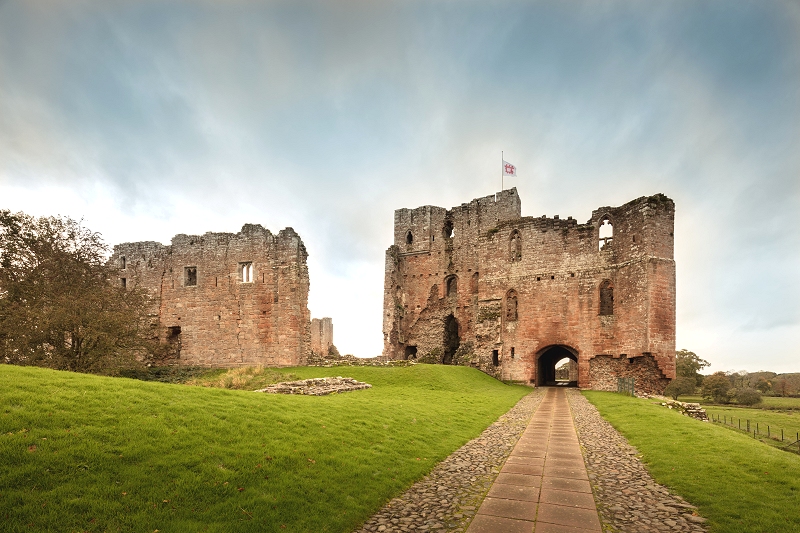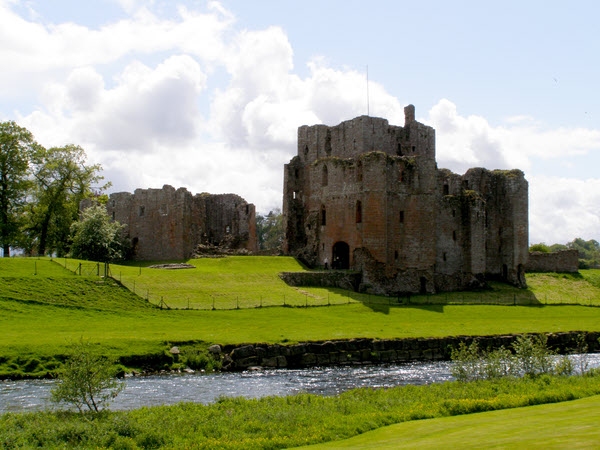
We head north and west toward Brougham and, as navigator, I decide there is a shorter, more direct route other than the one we had originally planned on. Um ... we do eventually get there. Once we spot the castle, which lies on the banks of the River Eamont, I think that I'm home-free and tuck the atlas between the seats. (I soon learn not to put the atlas away until Robin shuts the engine off.)
Driving past a dirt road directly in front of the castle, we notice a sign shaped like an arrow, pointing away from what seems to be the entrance. "The road must curve around to the back," I surmise. The road does curve, but away from the castle and soon turns into one of those single track roads that require a five-point turn to reverse your course, which we do.
Back where we had started, we stop at the corner. Robin gets out of the car and swings the sign around so it points toward the castle rather than away from it. As we drive past a cottage on the right, we notice a little girl of about ten years old sitting atop a stone wall swinging her feet. "Gotcha!" we imagine her saying to herself.
Like Barnard and Brough, Brougham Castle presents an imposing edifice. It has been maintained much better than Brough and the red sandstone walls seem to radiate warmth in the chilly afternoon air. We enter through the gatehouse and follow a path to a large cobbled courtyard. There is a family here, a child of about two years old standing amid the wobbly stones on her wobbly little legs and her mother and brother encouraging her to "Come on then, you can do it." The child looks uncertain, I am uncertain, but after a moment she toddles right over to them.
We set about exploring all of the nooks and crannies of Brougham as thoroughly as we did Barnard and Brough. Up and down spiral staircases, into large chambers, peering out of windows. Again, we miss nothing.
A sign in the courtyard relates that Edward I visited here on 22 July 1300. "Longshanks," I think, and my Wallace blood boils a little, but I am amazed to be walking where he once did. One passage is blocked off with a wrought iron gate and we peer up into the dim light.
An immense nest is wedged in this area, a nest worthy of a raptor of very large proportions. Visions of pteranodons fill my head and we joke about how very ancient this site must be. In reality, it's probably the nest of an eagle, we decide, and vow to try to find out what sort of birds of prey are native to the area.

Brougham Castle is a medieval building about 2 miles south-east of Penrith, Cumbria, England. The castle was founded by Robert I de Vieuxpont in the early 13th century. The site, near the confluence of the rivers, Eamont and Lowther, had been chosen by the Romans for a Roman fort called Brocavum.
In its earliest form, the castle consisted of a stone keep, with an enclosure protected by an earthen bank and a wooden palisade. When the castle was built, Robert de Vieuxpont was one of the only lords in the region who were loyal to King John.
The Vieuxponts were a powerful land-owning family in North West England, who also owned the castles of Appleby and Brough. In 1264, Robert de Vieuxpont's grandson, also named Robert, was declared a traitor, and his property was confiscated by Henry III. Brougham Castle and the other estates were eventually returned to the Vieuxpont family, and stayed in their possession, until 1269, when the estates passed to the Clifford family through marriage.
With the outbreak of the Wars of Scottish Independence, in 1296, Brougham became an important military base for Robert Clifford, 1st Baron de Clifford. He began refortifying the castle: the wooden outer defences were replaced with stronger, more impressive stone walls, and a large stone gatehouse was added. The importance of Brougham and Robert Clifford was such that, in 1300, he hosted King Edward I of England at the castle.
Read more about Brougham Castle at Wikipedia.